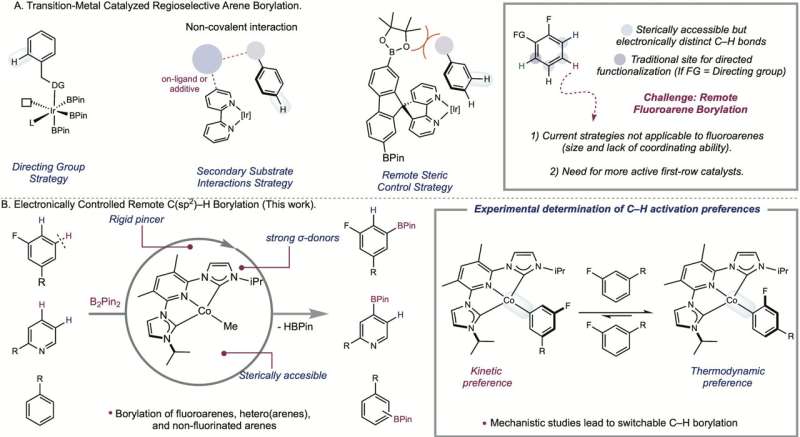This article has been reviewed according to Science X's editorial process and policies. Editors have highlighted the following attributes while ensuring the content's credibility:
fact-checked
peer-reviewed publication
trusted source
proofread
A catalyst for electronically controlled C–H functionalization

The Chirik Group at the Princeton Department of Chemistry is chipping away at one of the great challenges of metal-catalyzed C–H functionalization with a new method that uses a cobalt catalyst to differentiate between bonds in fluoroarenes, functionalizing them based on their intrinsic electronic properties.
In a paper published this week in Science, researchers show they are able to bypass the need for steric control and directing groups to induce cobalt-catalyzed borylation that is meta-selective.
The lab's research showcases an innovative approach driven by deep insights into organometallic chemistry that have been at the heart of its mission for over a decade. In this case, the Chirik Lab drilled down into how transition metals break C–H bonds, uncovering a method that could have vast implications for the synthesis of medicines, natural products, and materials.
And their method is fast—comparable in speed to those that rely on iridium.
The research is outlined in "Kinetic and Thermodynamic Control of C(sp2)–H Activation Enable Site-Selective Borylation," by lead author Jose Roque, a former postdoc in the Chirik Group; postdoc Alex Shimozono; and P.I. Paul Chirik, the Edwards S. Sanford Professor of Chemistry and former lab members Tyler Pabst, Gabriele Hierlmeier, and Paul Peterson.
'Really fast, really selective'
"Chemists have been saying for decades, let's turn synthetic chemistry on its head and make the C–H bond a reactive part of the molecule. That would be incredibly important for drug discovery for the pharmaceutical industry or for making materials," said Chirik.
"One of the ways we do this is called C–H borylation, in which you turn the C–H bond into something else, into a carbon–boron bond. Turning C–H to C–B is a gateway to great chemistry."
Benzene rings are highly represented motifs in medicinal chemistry. However, chemists rely on traditional approaches to functionalize them. The Chirik Group develops new methods that access less-explored routes.
"Imagine you have a benzene ring and it has one substituent on it," Chikik added. "The site next to it is called ortho, the one next to that is called meta, and the one opposite is called para. The meta C–H bond is the hardest one to do selectively. That's what Jose has done here with a cobalt catalyst, and no one's done it before."
"He's made a cobalt catalyst that is really fast and really selective."
Roque, now an assistant professor in Princeton's Department of Chemistry, said rational design was at the heart of their solution.
"We started to get a glimpse of the high activity for C–H activation early during our stoichiometric studies," said Roque. "The catalyst was rapidly activating the C–H bonds of aromatic solvents at room temperature. In order to isolate the catalyst, we had to avoid handling the catalyst in aromatic solvents," he added.
"We designed an electronically rich but sterically accessible pincer ligand that we posited—based on some previous insights from our lab as well as some fundamental organometallic principles—would lead to a more active catalyst."
"And it has."
A lab target since 2014
State-of-the-art borylation uses iridium as a catalyst for sterically driven C–H functionalization. It is highly reactive, and it is fast. But if you have a molecule with many C–H bonds, iridium catalysts fail to selectively functionalize the desired bond.
As a result, pharmaceutical companies have appealed for an alternative with more selectivity. And they've sought it among first-row transition metals like cobalt and iron, which are less expensive and more sustainable than iridium.
Since their first paper on C–H borylation in 2014, the Chirik Lab has articulated the concept of electronically controlled C–H activation as one answer to this challenge. Their idea is to differentiate between C–H bonds based on electronic properties in order to functionalize them. These properties are reflected in the metal-carbon bond strength. With the catalyst designed in this research, chemists can hit the selected bond and only the selected bond by tapping into these disparate strengths.
But they uncovered another result that makes their method advantageous: the site selectivity can be switched by exploiting the kinetic or thermodynamic preferences of C–H activation. This selectivity switch can be accomplished by choosing one reagent over another, a process that is as streamlined as it is cost-effective.
"Site-selective meta-to-fluorine functionalization was a huge challenge. We made some great progress toward that with this research and expanded the chemistry to include other substrate classes beyond fluoroarenes," said Roque. "But as a function of studying first-row metals, we also found out, hey, we can switch the selectivity."
Added Chirik, "To me, this is a huge concept in C–H functionalization. Now, we can look at metal-carbon bond strengths and predict where things are going to go. This opens a whole new opportunity. We're going to be able to do things that iridium doesn't do."
Shimozono came to the project late in the game after Roque had already discovered the pivotal catalyst. His role will deepen in the coming months as he seeks new advances in borylation.
"Jose's catalyst is groundbreaking. Usually, a completely different catalyst is required in order to change site selectivity," said Shimozono. "Counter to this dogma, Jose demonstrated that using B2Pin2 as the boron source affords meta selective chemistry while using HBPin as the boron source gives ortho selective borylation using the same iPrACNCCo catalyst.
"In general, the more methods we have to install groups in specific sites in molecules, the better. This gives pharmaceutical chemists more tools to make and discover medications more efficiently."
More information: Jose B. Roque et al, Kinetic and thermodynamic control of C(sp2)–H activation enables site-selective borylation, Science (2023). DOI: 10.1126/science.adj6527. www.science.org/doi/10.1126/science.adj6527
Journal information: Science
Provided by Princeton University





















